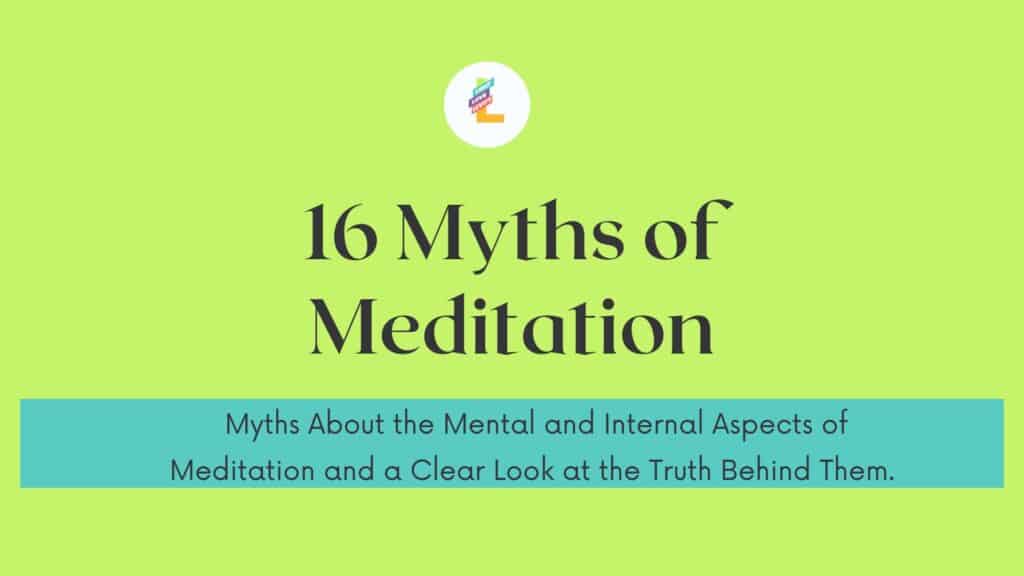Let’s take a look at some of the common myths about the mental and internal aspects of meditation. First things first: Meditation is as complex as your mind and as simple as sitting down and breathing. Even if you’re unsure about the details, you’ve probably heard that meditation is good for you, and it is. In addition to managing stress, mindfulness practices have been linked to better outcomes for patients with heart disease, cancer, high blood pressure, depression, and many other conditions. At the very least, meditation helps to clear the mind, soothe the nervous system, and leave you feeling calm & refreshed. Now, we set these common myths of meditation free.
Meditation Myths
There are many myths about meditation because it’s an umbrella word used to describe different processes. For example, “meditation” can mean introspection, reflection, self-examination, contemplation or to become completely clear. It’s easy to see why it’s sometimes misunderstood because meditation isn’t a 1-dimensional process. This guide will help you sort out the facts so you can discover the true benefits of meditation and how it can change your life for the better. Before we begin, let’s all acknowledge that meditation practices are full of contradictions and diversity. Depending on their root origins and philosophies, the look, feel, and objective (or lack thereof) of different meditation practices will vary. Regardless, they’re all immensely rewarding and worth the effort. So, here we go, time to clear up the myths of meditation to boost your physical and mental well-being.
The 16 Most Common Myths of Meditation
Myth 1: Breathing is just for beginners.
Truth: Look, for the most part, breathing is a natural, subconscious process. We all know how to do it to some degree or we wouldn’t be here. The thing is, our conditioned breathing habits are usually sub-optimal. When it comes to meditation and breathing practice, we start out easy: Watching your breathing or counting your inhalations and exhalations is a common technique in the beginning. There are many different techniques to explore, so yes, breathing IS for beginners. But also, for everyone, all the time. Many techniques are considered intermediate or advanced so beginners work up to them. *Train carefully because different breaths (patterns of both inhalations and exhalations) impact the mind and body in various ways. However, deep and relaxed breathing is essential at every stage of meditation.
Myth 2: Progress feels gradual and steady.
Truth: Expect fluctuations. Some sessions will go smoothly and sometimes you’ll struggle. We’re human! Life, and meditation practice, ebbs & flows. Regularly, one of the biggest misconceptions I hear is “it’s not working”… To which, I lovingly point out that mindfully failing to meet our own expectations of progress, IS progress. Every day, every breath, and everybody is different.
Myth 3: Meditation is easy.
Truth: Mindfulness can be hard work. Essentially, we are rewiring our brain’s focus and conditioning. To make breakthroughs in thinking, address your automatic defenses. To set out in a more positive direction, the work is in transforming your entrenched habits. Like most things, meditation IS easy with time, cultivation, and practice.
Myth 4: Meditation is difficult.
Truth:
You are capable of overcoming challenges. Plus, this has been PROVEN wrong by many awesome human beings who meditate regularly.It is actually NOT too hard at all. Sitting with yourself isn’t always easy, but meditation can also be simple and fun. Be gentle with yourself. Lighten up and enjoy the process. Remember, you’re in meditation to observe, not to judge, criticize, or react. In the moments that we find meditation most difficult, there is often a lot to learn.
Myth 5: Concentrate first.
Truth: Yes, and no. Here’s the thing, your thoughts may be accustomed to racing around. In that case, active concentration (on breath or visuals) can help filter down what’s happening in your monkey mind. Over time, you will enhance your ability to concentrate, and eventually surpass that into a state of clear absorption.
Myth 6: Zoning out is the ultimate goal.
Truth: Hmm…not really.Sure, ‘zoning out’ is the ultimate goal of some types of meditation. Although meditation can also be used just to relax, problem solve, observe, etc. You can also use your sessions to sort out personal issues or seek spiritual attainments. When we say things like X is “the ultimate goal” we’re kind of circumventing the benefits of the process as a whole. While it’s true that meditation can sometimes feel like “zoning out,” the ultimate goal of meditation is not to simply detach from the world or one’s thoughts. Instead, meditation is a practice that aims to cultivate a state of mindful awareness and inner peace. Through techniques such as focused breathing, visualization, or mantra repetition, meditation can help individuals develop a deeper understanding of their thoughts and emotions, reduce stress and anxiety, and enhance overall well-being. Rather than escaping from reality, meditation encourages us to be more fully present and engaged with ourselves and the world around us.
Myth 7: It’s some kind of religion.
Truth: Meditation is a traditional part of many religions. It is also sometimes considered synonymous with “prayer”. However, it is up to you to designate what meditation is in your life. It can be adapted to your personal spiritual beliefs or be a completely secular activity. For a lot of people, meditation is simply an exercise of the mind, while others find it to be a sacred process. Either way, the benefits remain the same. In my experience, many people who have had an adverse experience with religion often find solace in healing those experiences through meditation.
Myth 8: You’ll wind up isolated.
Truth: This one always baffles me. I don’t know if it stems from the imagery of monks meditating daily for long hours or what, but I have never run across a case where meditating harmed someones social relationships. In fact, sitting by yourself can actually strengthen your connections with others. As you connect more deeply and fully with yourself, you develop more love and compassion for those around you.
Myth 9: It’s okay to discontinue medical treatment.
Truth: Ummm. No. The only person capable of making that decision is you. It’s important to understand that meditation is part of a healthy self-care routine. Self-care and healthcare are separate things. Make Sure Your Self-Care Compliments Your Healthcare. Please talk with your doctor before making any decisions about changing your physical or mental health routine. Meditation may reduce your need for prescription drugs or it may be a helpful supplement to conventional care. While the impulse to ‘ditch it all’ for a more holistic approach to self-care seems to be popular, it is NOT the safest decision. Be mindful, speak with all the professionals who help you manage your conditions, and take a safe, responsible, teamwork approach.
Myth 10: Only the full lotus position counts.
Truth: This is ridiculous. Take a seat that’s comfortable for you. That may mean a half lotus on the floor or sitting in a straight-backed chair. Some meditations are even designed to be performed standing, and/or laying down. There is no ‘one position that trumps the rest’. That said, your alignment IS important, as it provides the scaffolding of the body which creates space for the movement of breath. Essentially, it is more important that your breath has clear, open channels to travel than it is for you to assume any one particular position. Honor YOUR body and YOUR breath.
Myth 11: Aches and pains are good.
Truth: Aches and pains are the body’s natural alarm system telling you that something is going on. In that respect, it is important that we notice and observe them. However, and this seems so obvious, but I’m going to state it anyway: Change positions if you feel stiff or get a cramp. Scan your body to detect areas of tension and make adjustments. in doing so, you’ll eliminate distractions and protect your body from injury. In meditation practice, we are learning to observe and unwrap physical sensations from mental and emotional responses. Over time, we learn how to distinguish between slight discomfort and true aches and pains. It is up to you to decide which ways you are willing to sit in discomfort and make adjustments accordingly. There is no need for unnecessary suffering.
Myth 12: Teachers are useless.
Truth: You can learn a lot from books and videos, and even more through practicing yourself. There is nothing wrong with independent exploration. However, live teacher interactions are even better because you can form a warm and supportive relationship, as well as gain information and feedback that would be otherwise inaccessible to you. Feeling accountable to another person may also encourage you to practice more consistently.
Myth 13: Expensive props make a big difference.
Truth: I see what you’re saying here… I love all the shiny, fluffy, new things as much as the next person but, be real. What matters is your mind. That $99 floor cushion isn’t going to do the meditation for you. Keep it simple. Go ahead and select a cushion that works well for you. You can also use your bed pillow or an old phonebook. Your mind is what really counts. Props can be nice, but they are not necessary. Don’t forget, as you grow your meditation practice, there is great clarity to be revealed in teasing out the true differences between wants and needs.
Myth 14: Absolute quiet is essential.
Truth: Silence IS conducive to meditation, but it can be difficult to find in the modern world, and it isn’t essential. The idea is to evolve your practice into something that you can do anywhere, despite what is happening around you. As teachers, we often cultivate silent spaces when working with new students simply because it allows you to focus on strengthening your familiarity with the process. In time, some meditations can be done on a busy sidewalk, or under any other environmental conditions. Work on accepting background noise with a peaceful mind.
Myth 15: It requires a LOT of time.
Truth: You can meditate for just a few minutes a day, or for an entire day. It’s up to you. Focus on your breathing when you’re stuck at a red light. Not every day is a vacation to an ashram. Remind yourself of all you have to be grateful for while you’re waiting for your coffee to brew. It CAN be all of these things, or not. One of the most beautiful aspects of meditation is its portability and flexibility.
Myth 16: It requires LITTLE time.
Truth: Sure, it can, but prolonged contemplation leads to deeper insights. There’s synergy in what you put into it versus what you get out of it. When it comes to YOU, do you really want to cut corners? How much time is cultivating your inner peace worth to you? That doesn’t make any length of meditation bettor or worse, but its functionality will vary from form to form. You can always adjust your priorities depending on what you want to accomplish. If you only have a little time, take a little time, if you have a lot, take that when it suits you too.
Ditch the Myths and Do What Feels Right
These 16 myths of meditation aren’t the only ones out there, but they drive home the point: meditation is whatever you allow it to be for you. Don’t let any “shoulds” or myths stand in your way. Myths of meditation are just that: fabrications built on falsehoods. If you’re new to meditation, learn about how yoga and meditation help balance your mind and body. For those of you who’ve been giving it a go for a while already, check out these 8 tips for better meditation at home. Do what feels right for you and let everything else go.
Namaste.
~Meg


